|
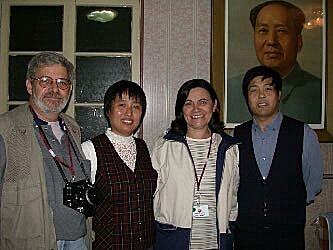 Anne
and I with the local family we visited
Anne
and I with the local family we visited |
Visiting
a foreign country is one thing, but mingling with and getting to know
some of the locals is a completely different story. On our excursion
through the hutong we stopped and had tea and snacks with one of the
local families (left). Julia, a local guide, interpreted for us so
allowing us to ask questions and understand the responses. In the
family we visited the mother was employed at a shoe factory and the
father in the airline food service business. They had one son, a teenager,
who was out playing as they often are. I'm not sure how many rooms
their apartment was (I think 2). The room we sat in served as the
kitchen, the dining room, the family room and even a bedroom. They
had many modern conveniences including a refrigerator, stove, television
and computer, but the reality was that they lived in cramped quarters
with little privacy. |
|
|
Of
course Anne and I learned little of the Chinese lifestyle in the
short time we visited, but we did get a glimpse of what their life
was like. A better, more detailed glimpse was provided by our local
tour guides. Quite often, after they finished talking about the
day's sightseeing itinerary, they would discuss their personal lives
and the lives of the Chinese including education, housing, employment,
medical and retirement.
Our
local guide in Beijing, Jack, being the first we were exposed to
explained much about daily in China to us and the changes that are
being brought about by the new "free market" economy.
Jack was a communist and proud of it. You could tell from the way
he talked that he credited China's communist party for the advances
they'd made over the years. Julia, our local guide in Shanghai,
was in her early 20's and described what life was like for the young
Chinese today. Shanghai has always been somewhat different from
the rest of China and you could tell that when you compared what
Julia said to what the other guides said. Our local guide in Suzhou,
I forget her name, was middle aged and described what life was like
during and following the Cultural Revolution. Among the things they
described were:
- China's
"one child" policy. Depending on where you live Chinese
couples are discouraged from having more than one child and are
penalized for breaking this rule. In Chinese society this is a
difficult rule to abide with especially if your first child is
a girl. The Chinese have always looked upon boy children as being
the center of the family.
- China's
housing situation. With the new "free market" economy
housing is changing very quickly in China. It is possible now
for the Chinese to buy and own their apartments, although the
costs is quite high.
- Jack
described growing up in crowded living conditions. Apparently
his family had an apartment on the 15th or 16th floor of a building
consisting of two or three rooms. The room sizes were small, as
he described it, with barely enough room to walk around the furniture
in the room. Kitchen and bathroom facilities were shared with
other families living in adjacent apartments. He described how
his father hated the apartment because of his shift work. Apparently
when he returned home from work the electrical power to the building
was turned off and he had to climb the stairs to get to his apartment.
- Both
Julia and Jack also described how apartments were controlled by
the companies their parents worked for, and how, as the father's
position and tenure with his employer continued, they got better
and better apartments because of their job. The better job and
the longer you were employed by the company allowed you to get
a better apartment.
- Jack,
his wife and two children, still lived with his parents in what
he described as a very comfortable apartment. As he described
it, living in his father's apartment they were much better off
than what he would have if he decided to live on his own. Of course
what he described, although modern, was still very cramped living
conditions. I believe they had a total of about 1,200 sq. feet
for his family, his parents and another sibling.
- Julia
described a very comfortable lifestyle living with her parents
and even indicated that she might not be willing to give up her
lifestyle to get married. Apparently when girls marry they go
to live with the parents of the boy meaning she'd have to give
up her lifestyle and accept what the boy had to offer. Her father,
employed by the same company for 26 years, had a spacious apartment
and she was allowed to have her own room with lots of privacy.
- Our
local guide in Suzhou, who grew up in the midst of the Cultural
Revolution, described how that affected their lives. She and her
husband were both educated people, but that was totally disregarded
during the Cultural Revolution as they were designated to perform
menial jobs. During their years of marriage they apparently moved
a number of times. She described how, each time, they had to get
the permission of the government to move from one province in
China to another. You just couldn't pick up and move anywhere
you wanted. In fact, your citizenship was based on the province
where you were born and, for the most part, that was where you
have to live.
I
know I haven't done justice in describing all these things, but
it give you an inkling somewhat into the lives of the local Chinese
that we were exposed to during our trip. While my descriptions may
not be 100% accurate they are what I remember most of the discussion
we had during our many bus rides. You have to keep in mind that,
most of the time, I was looking out the window of the bus soaking
up the countryside and the different things I saw and not always
paying close attention to what was being said in the bus by the
tour guide.
|
|
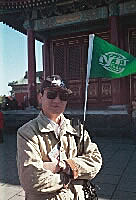 Jack,
Beijing
Jack,
Beijing |
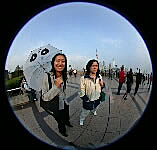 Julia,
Shanghai
Julia,
Shanghai |
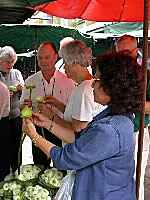 Sansanee,
Bangkok
Sansanee,
Bangkok |
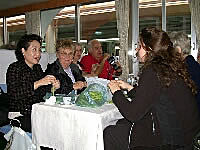 Mei,
Tour Escort
Mei,
Tour Escort |
|
|
As
I've mentioned previously, GCT did an excellent job in providing
knowledgeable and friendly local guides throughout our trip, and
our tour escort, Mei, well, there isn't any better. She was effective
in taking care of any problems that arose and she was extremely
friendly. She knew how to win your affection and she earned it every
day. I'll tell you one of her secrets. Every time we boarded the
bus after touring a site she had something to hand out to the group.
It it wasn't a piece of candy, it was a piece of some exotic fruit
we'd never seen before, or maybe just a wet-nap to refresh ourselves
with. Several times during the trip she would visit a local market
and pick up some vegetables to have the cooks at lunch or dinner
prepare for us. She was always doing something like that, and we
all appreciated it.
Speaking
of food. Many worry about visiting a place like China expecting
that the diet won't agree with them. We found it to be the exact
opposite. The five of use went the entire trip with absolutely not
tummy problems at all, and we know of only one person who had a
problem for one day. But, I'll warn you about this. You better like
Chinese food because you're going to get a lot of it. Breakfast,
lunch and dinner were provided almost every day of the tour with
the rare exception. For breakfast it was usually buffet with a choice
of either eastern or western style food. For lunch it was always
Chinese. Chinese lunches were great because there were about eight
courses altogether including a soup so you were always sure you'd
get several things that you liked and could fill up on. Dinners
were Chinese for the most part with a few western style thrown in
for good measure.
After
our tour of the hutong and visit with the local family we were scheduled
to have dinner at a nearby Schezuan restaurant and then attend a
performance of the Chinese opera. The rickshaw drivers took us from
the hutong right to the restaurant which was located in a wooded
area. The restaurant appeared to be very nice and, as most were,
popular. It should be mentioned that every place we ate bore a sign
at the entrance advising that it was approved for foreign tourist
by the government. I'm not quite sure of the significance of the
sign. Was it merely an inspection sticker, or was there some government
restrictions placed on where tour operators could take foreign tourist?
You did get the feeling that the government wanted to control the
tourist's perception of China and controlling where they ate to
insure quality and service might be one small step in doing so.
I should mention this same sign was prominent in all of the hotels
we stayed at.
|
|
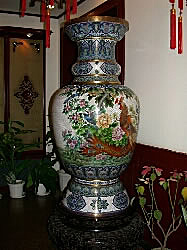 Beautiful
cloisonné vase
Beautiful
cloisonné vase |
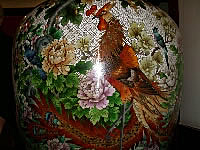 Close-up
of the vase
Close-up
of the vase |
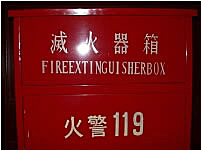 Fire
extinguisher
Fire
extinguisher |
|
| |
|
Entering
the restaurant two things immediately caught my eye. First, an absolutely
beautiful and large cloisonné vase (stick around to see how
these Chinese artworks are made later in the album), and a fire extinguisher.
Note the sign on the fire extinguisher. Such presentations of English
words without spacing between the words was common. Would you believe,
it took me a minute to actually figure out what the sign said.
|
|
|
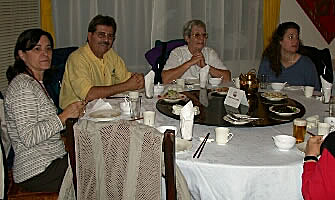 Anne,
John,Carol and Alicia
Anne,
John,Carol and Alicia
patiently awaiting dinner's arrival |
|
|
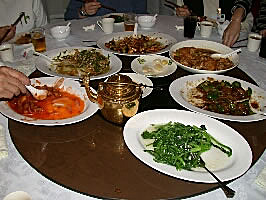 Traditional
Chinese table
Traditional
Chinese table
complete with a Lazy Susan |
|
|
|
|
|
|
|
|
|
|
|
|
|
|
|
|
| One
of the things we've always enjoyed about Chinese food is the variety
of dishes you get to experience and with groups like ours where each
table had eight to ten people you really enjoyed the experience. Without
exception for each eastern style meal we were seated at a round table
with a Lazy Susan occupying the center. The dishes were brought and
placed on the Lazy Susan where everyone had easy access by just rotating
the Lazy Susan. It did take a bit of coordination to make sure that
everyone was ready for it to be turned, but we learned that quickly.
Each meal consisted of eight (and sometimes more) courses including
fish, meat, pork and a variety of vegetables. And, for the most part,
we were never disappointed in the food. It was all very good. |
|
|
|
|
|
|
|
|
|
|
|
|
|
|
|
| Leaving
the restaurant we walked through a wooded park to the Chinese Opera.
The park was beautiful as it was bathed in a soft green light. |
|
|
|
|
|
|
|
|
|
|
|
|
|
|
|
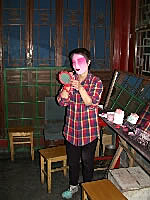 Performer
putting
Performer
putting
on makeup |
|
| Unfortunately
our visit to the Chinese Opera was a "forgettable" experience.
Actually not! The Chinese are right ... we westerners are just not
ready for Chinese Opera. It's a mixture of song, dance and gymnastics,
unfortunately, the songs are terrible and incomprehensible by us.
The pageantry and costumes were superb though. |
|
|
|
|
|
|
|
|
| With
the end of this day one of the highlights of the trip for all of us
was coming up the next morning ... our visit to the Great Wall of
China. Continue to the next page to see what that day brought ... |
|
|
|
|
|
|
|
|
|
|
|
|
|
|
|
|
|
|
|
|
|
|
|
|
|
|
|
|

